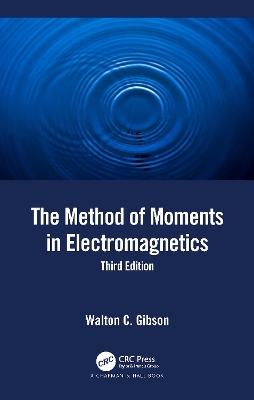
The Method of Moments in Electromagnetics
Chapman & Hall/CRC (Verlag)
978-1-032-04232-9 (ISBN)
The Method of Moments in Electromagnetics, Third Edition details the numerical solution of electromagnetic integral equations via the Method of Moments (MoM). Previous editions focused on the solution of radiation and scattering problems involving conducting, dielectric, and composite objects. This new edition adds a significant amount of material on new, state-of-the art compressive techniques. Included are new chapters on the Adaptive Cross Approximation (ACA) and Multi-Level Adaptive Cross Approximation (MLACA), advanced algorithms that permit a direct solution of the MoM linear system via LU decomposition in compressed form. Significant attention is paid to parallel software implementation of these methods on traditional central processing units (CPUs) as well as new, high performance graphics processing units (GPUs). Existing material on the Fast Multipole Method (FMM) and Multi-Level Fast Multipole Algorithm (MLFMA) is also updated, blending in elements of the ACA algorithm to further reduce their memory demands.
The Method of Moments in Electromagnetics is intended for students, researchers, and industry experts working in the area of computational electromagnetics (CEM) and the MoM. Providing a bridge between theory and software implementation, the book incorporates significant background material, while presenting practical, nuts-and-bolts implementation details. It first derives a generalized set of surface integral equations used to treat electromagnetic radiation and scattering problems, for objects comprising conducting and dielectric regions. Subsequent chapters apply these integral equations for progressively more difficult problems such as thin wires, bodies of revolution, and two- and three-dimensional bodies. Radiation and scattering problems of many different types are considered, with numerical results compared against analytical theory as well as measurements.
Walton C. Gibson was born in Birmingham, Alabama, USA on December 9, 1975. He received the B.S. degree in electrical engineering from Auburn University in 1996, and the M.S. degree in electrical engineering from the University of Illinois Urbana-Champaign in 1998. He is a recognized authority in the area of computational electromagnetics (CEM), and has authored The Method of Moments in Electromagnetics, a textbook geared to graduate-level courses in CEM, as well as the research community and practicing professionals. He is the owner and President of Tripoint Industries, Inc., through which he has authored lucernhammer, an industry-standard suite of radar cross section solver codes implementing low and high-frequency numerical techniques. His professional interests include electromagnetic theory, computational electromagnetics, moment methods, numerical algorithms and parallel computing.
1. Computational Electromagnetics. 1.1. CEM Algorithms. 2. The Method of Moments. 2.1. Electrostatic Problems. 2.2. The Method of Moments. 2.3. Common One-Dimensional Basis Functions. 3. Radiation and Scattering. 3.1. Maxwell’s Equations. 3.2. Electromagnetic Boundary Conditions. 3.3. Formulations for Radiation. 3.4. Vector Potentials. 3.5. Near and Far Field. 3.6. Formulations for Scattering. 4. Solution of Matrix Equations. 4.1. Direct Methods. 4.2. Iterative Methods. 4.3. Software for Linear Systems. 5. Thin Wires. 5.1. Thin Wire Approximation. 5.2. Thin Wire Excitations. 5.3. Hallen’s Equation. 5.4. Pocklington’s Equation. 5.5. Thin Wires of Arbitrary Shape. 5.6. Examples. 6. Two-Dimensional Problems. 6.1. Conducting Objects. 6.2. Dielectric and Composite Objects. 7. Bodies of Revolution. 7.1. BOR Surface Description. 7.2. Expansion of Surface Currents. 7.3. EFIE. 7.4. MFIE. 7.5. Solution. 7.6. nMFIE. 7.7. Numerical Discretization. Notes on Software Implementation. Examples. 7.10. Treatment of Junctions. 8. Three-Dimensional Problems. 8.1. Modeling of Three-Dimensional Surfaces. 8.2. Expansion of Surface Currents. 8.3. EFIE. 8.4. MFIE. 8.5. nMFIE. 8.6. Enforcement of Boundary Conditions. 8.3. Software Implementation Notes. 8.8. Numerical Examples. 9. Adaptive Cross Approximation. 9.1. Rank Deficiency. 9.2. Adaptive Cross Approximation. 9.3. Clustering Techniques. 9.4. LU Factorization of ACA-Compressed Techniques. 9.5. Solutionof theACA-Compressed Matrix System. 9.6. Software Implementation Notes. 9.7. Numerical Examples. 10. Multi-Level Adaptive Cross Approximation. 10.1. MLACA Compression of Matrix Blocks. 10.2. Direct Solution of MLACA-Compressed Matrix System. 10.3. Software Implementation Notes. 10.4. Numerical Exqamples. 11. The Fast Multipole Method. 11.1 The N-Body Problem. 11.2. Matrix-Vector Product. 11.3. One-Level Fast Multipole Algorithm. 11.4. Multi-Level Fast Multipole Algorithm (MLFMA). 11.5. Preconditioners. 11.6. Software Implementation Notes. 11.7. Numerical Examples. 12. Integrations. 12.1. One-Dimensional Integration. 12.2. Integration over Triangles. A. Scattering Using Physical Optics. Index.
| Erscheinungsdatum | 19.07.2021 |
|---|---|
| Zusatzinfo | 228 Line drawings, black and white; 228 Illustrations, black and white |
| Sprache | englisch |
| Maße | 152 x 229 mm |
| Gewicht | 940 g |
| Themenwelt | Mathematik / Informatik ► Mathematik ► Angewandte Mathematik |
| Naturwissenschaften ► Physik / Astronomie ► Elektrodynamik | |
| Technik ► Elektrotechnik / Energietechnik | |
| Technik ► Umwelttechnik / Biotechnologie | |
| ISBN-10 | 1-032-04232-X / 103204232X |
| ISBN-13 | 978-1-032-04232-9 / 9781032042329 |
| Zustand | Neuware |
| Haben Sie eine Frage zum Produkt? |
aus dem Bereich


